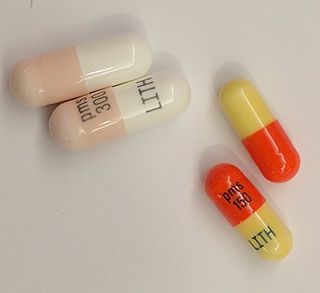Psychiatry
Lithium Carbonate: The Penicillin of Psychiatry
The fascinating history of psychiatry's most specific and effective drug.
Posted August 17, 2019 Reviewed by Abigail Fagan
Two thousand years ago, Roman physicians would send their nervous and temperamental patients to bathe in particular springs in western and southern Europe to treat their psychological ailments. We now know that these specific bath springs contain the highest natural concentration of lithium salts anywhere in Europe. Without knowing it, the Romans discovered the therapeutic value of lithium thousands of years before it was (re)discovered by John Cade in 1948 as a treatment for manic depression.

Today, lithium carbonate remains the most specific and effective drug in all of psychiatry. Dubbed the "penicillin of mental health" and a gold standard in the treatment of bipolar disease, lithium is listed as an essential medicine by the World Health Organization.
But the consequences of lithium go well beyond its clinical use in bipolar disorder; its discovery ushered in a new wave in psychiatry: the use of psychoactive medications to treat mental disturbances. Shortly after Cade's seminal research in the late 1940s, other landmark drugs like chlorpromazine and imipramine were developed for schizophrenia and major depression, respectively. The biological revolution in psychiatry was born.
Although lithium was discovered to be effective as a psychiatric drug in 1948, it took 22 years for it to gain approval by the U.S. Food and Drug Administration as a treatment for manic depression. The reason: American pharmaceutical companies wanted nothing to do with lithium. As a natural salt (appearing on the periodic table of the elements), lithium could never be patented. It would never be a money-maker for the drug companies. Still today, some argue (with good reason) that lithium is underprescribed in the U.S. in favor of the newer, more profitable mood stabilizers and neuroleptics. Certainly, the rates of lithium use are much lower in America than in the rest of the world (see Ruffalo, 2017; Shorter, 2009).
After its discovery in Australia, lithium was introduced in the United States by the young psychiatrist Ronald Fieve, who helped establish the first lithium clinic in the U.S. at Columbia University. Fieve went on to become a world-renowned psychiatrist, researcher of bipolar disorder, and advocate for lithium therapy. Frequently appearing on television and radio shows to tout the effectiveness of lithium, he remained one of America's leading proponents of the drug until his death in 2018. He is also responsible for the conceptualization of bipolar II disorder, a variant of which he termed "bipolar beneficial." (See my obituary of Fieve here.)
Perhaps the most interesting finding on lithium comes from the epidemiological research. In the 1970s, El Paso, Texas, was found to have the highest concentration of lithium salts in the public water supply of any U.S. city. Psychiatric hospital admissions were one-seventh the percentage that they were in Dallas, which has the lowest levels of lithium in Texas. El Paso also had significantly lower rates of suicide, violent crime, and drug abuse. Findings such as these led some public health psychiatrists to propose adding lithium to the water supply nationally, similar to fluoride, though these suggestions were never adopted (see Fieve, 1975).
Lithium's utility in psychiatry goes beyond its well-established effectiveness in the treatment of bipolar mania. Research indicates that it is also an effective treatment for recurrent unipolar depression (Bschor, 2014). It also has application in the prophylactic treatment of bipolar manic psychosis (Rosenthal et al., 1979). While many younger psychiatrists decry the potential side effects of lithium's long-term use, I believe the critique may be overstated and a result of years of anti-lithium drug company marketing. Low-dose lithium can be safe, effective, and well-tolerated for many years.

Lithium also has the added benefit of being an all-natural drug, a fact that appeals to many patients. While mood-stabilizing medication has a reputation of "cutting into" a person's manic creativity, Fieve demonstrated in the 1970s that lithium actually enhances creativity in the bipolar patient. In fact, much of Fieve's research attempted to harness the beneficial aspects of mania and hypomania—both for the patient and for society. He argued that many U.S. presidents, business leaders, and wall street tycoons had some form of bipolar illness.
Exactly how and why lithium works remains a mystery. One of Cade's earlier hypotheses about mania being caused by a lithium deficiency in the body turned out to be false. Yet, there is some reason to believe that lithium is an essential element necessary for human life, much like sodium and potassium. There is much evidence demonstrating lithium's neuroprotective effects, and it is currently being investigated for use in the neurodegenerative disorders, including Alzheimer's disease, amyotrophic lateral sclerosis (Lou Gehrig's disease), and more recently, Parkinson's disease (Forlenza, De-Paula, & Diniz, 2014).
One thing is certain: Despite its waning popularity, lithium carbonate remains one of the most effective pharmacological treatments in psychiatry. There's reason to believe that lithium has saved more people from suicide in the past 70 years than all suicide hotlines, combined. It is a drug of paramount importance in the history of medicine and psychiatry, and its use and effectiveness should continue to be celebrated as one of the most significant achievements of modern medicine.
References
Bschor, T. (2014). Lithium in the treatment of major depressive disorder. Drugs, 74(8), 855-862.
Fieve, R. R. (1975). Moodswing: The third revolution in psychiatry. New York: Morrow.
Forlenza, O. V., De-Paula, V. R., & Diniz, B. O. (2014). Neuroprotective effects of lithium: Implications for the treatment of Alzheimer’s disease and related neurodegenerative disorders. ACS Chemical Neuroscience, 5(6), 443-450.
Rosenthal, N. E., Rosenthal, L. N., Stallone, F., Fleiss, J., Dunner, D. L., & Fieve, R. R. (1979). Psychosis as a predictor of response to lithium maintenance treatment in bipolar affective disorder. Journal of Affective Disorders, 1(4), 237-45.
Ruffalo, M. L. (2017). A brief history of lithium treatment in psychiatry. Primary Care Companion for Central Nervous System Disorders, 19(5). doi: 10.4088/PCC.17br02140
Shorter, E. (2009). The history of lithium therapy. Bipolar disorders, 11(Suppl 2), 4-9.


